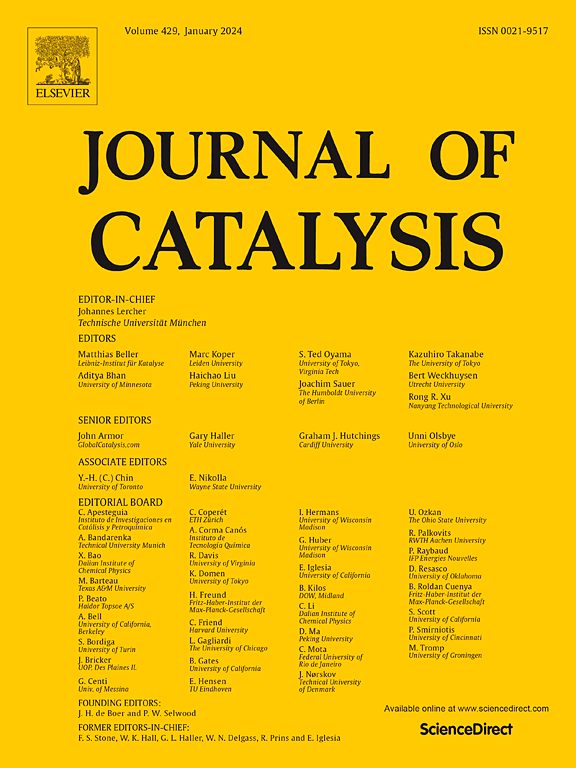ti3c2mxene作为碳二酰亚胺基化的非均相催化剂,转化率超过102 h−1
IF 6.5
1区 化学
Q2 CHEMISTRY, PHYSICAL
引用次数: 0
摘要
以Ti3AlC2为原料,采用NH4F-HCl蚀刻法制备了一系列Ti3C2样品,并进行DMSO膨胀、超声剥离、500 ℃热退火、过硫酸铵、氢氧化四丁基铵和盐酸表面改性等后处理。这些Ti3C2样品被用作芳香和仲脂肪胺对对称碳二酰亚胺进行胍基化反应的多相催化剂,观察到相应的胍基化合物的生成,并伴有二烷基脲。N,N ' -二异丙基碳二亚胺与对甲苯胺的初始反应速率与NH3热程序解吸法测定的Ti3C2样品的弱酸位密度呈线性相关。这使我们提出这些弱酸位点作为反应的活性中心。根据弱酸位点的分布,计算出最活跃的Ti3C2样品的周转率和频率分别为101和114 h−1。这些数值使Ti3C2成为迄今为止报道的活性最高的无贵金属固体胍化催化剂之一。重复使用后,Ti3C2样品逐渐失活,四次使用的Ti3C2样品的表征表明结晶度保持不变。催化剂失活源于反应产物在表面的沉积和/或氧化表面官能团在重复使用时的增加。失活可以通过热产物解吸部分逆转。DFT计算表明,反应机理中的速率决定步骤是碳二亚胺与锚定在Ti3C2表面的去质子化甲苯胺之间的环加成反应。目前的结果表明MXenes作为有机反应的固体催化剂的潜力,特别是Ti MXenes促进需要胺活化的反应,如目前的胍基化反应。本文章由计算机程序翻译,如有差异,请以英文原文为准。

Ti3C2 MXene as heterogeneous catalyst for carbodiimides guanylation with over 102 h−1 turnover frequencies
A series of Ti3C2 samples has been prepared from Ti3AlC2 by NH4F-HCl etching, followed by subsequent post-treatments, such as DMSO expansion, ultrasound exfoliation, thermal annealing at 500 °C, surface modification by ammonium persulfate, tetrabutylammonium hydroxide and hydrochloric acid. These Ti3C2 samples have been tested as heterogeneous catalysts for guanylation of symmetrical carbodiimides by aromatic and secondary aliphatic amines, observing the formation of the corresponding guanidines, accompanied by dialkylureas. The initial reaction rates between N,N’-diisopropylcarbodiimide and p-toluidine correlate linearly with the density of weak strength acid sites of the Ti3C2 sample measured by NH3 thermo-programed desorption. This has led us to propose these weak acid sites as active centers of the reaction. Based on the population of weak acid sites, the estimated turnover numbers and frequencies were calculated to be 101 and 114 h−1 for the most active Ti3C2 sample. These values rank Ti3C2 among the most active noble metal-free solid guanylation catalysts reported so far. Upon reuse, the Ti3C2 sample undergoes gradual deactivation, characterization of the four-times used Ti3C2 sample indicates that the crystallinity is preserved. Catalyst deactivation derives from deposition of the reaction products on the surface and/or from the increase of the oxygenated surface functional groups upon reuse. Deactivation can be partially reversed by thermal product desorption. DFT calculations indicate that the rate determining step in the reaction mechanism is the cycloaddition between the carbodiimide and the deprotonated toluidine anchored to the Ti3C2 surface. The present results illustrate the potential that MXenes have as solid catalysts for organic reactions, particularly Ti MXenes to promote reactions requiring amine activation, such as the present guanylation reaction.
求助全文
通过发布文献求助,成功后即可免费获取论文全文。
去求助
来源期刊

Journal of Catalysis
工程技术-工程:化工
CiteScore
12.30
自引率
5.50%
发文量
447
审稿时长
31 days
期刊介绍:
The Journal of Catalysis publishes scholarly articles on both heterogeneous and homogeneous catalysis, covering a wide range of chemical transformations. These include various types of catalysis, such as those mediated by photons, plasmons, and electrons. The focus of the studies is to understand the relationship between catalytic function and the underlying chemical properties of surfaces and metal complexes.
The articles in the journal offer innovative concepts and explore the synthesis and kinetics of inorganic solids and homogeneous complexes. Furthermore, they discuss spectroscopic techniques for characterizing catalysts, investigate the interaction of probes and reacting species with catalysts, and employ theoretical methods.
The research presented in the journal should have direct relevance to the field of catalytic processes, addressing either fundamental aspects or applications of catalysis.
 求助内容:
求助内容: 应助结果提醒方式:
应助结果提醒方式:


